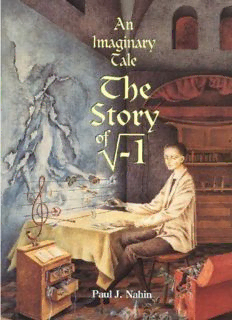
An Imaginary Tale: The Story of i the square root of minus one PDF
Preview An Imaginary Tale: The Story of i the square root of minus one
An Imaginary Tale An Imaginary Tale THE STORY OF 2-1 With a new preface by the author Paul J. Nahin PRINCETON UNIVERSITY PRESS PRINCETON AND OXFORD Copyright ©1998 by Princeton University Press Published by Princeton University Press, 41 William Street, Princeton, New Jersey 08540 In the United Kingdom: Princeton University Press, 3 Market Place, Woodstock, Oxfordshire OX20 1SY All Rights Reserved Fifteenth printing, and first paperback printing, with a new preface and appendixes by the author, 2007 Paperback ISBN-13: 978-0-691-12798-9 Paperback ISBN-10: 0-691-12798-0 The Library of Congress has cataloged the cloth edition of this book as follows Nahin, Paul J. An imaginary tale : the story of [the square root of minus one] / Paul J. Nahin. p. cm. On t.p. “[the square root of minus one]” appears as a radical over “–1”. Includes bibliographical references and indexes. 1. Numbers, Complex. I. Title. QA255.N34 1998 ISBN 0-691-02795-1 (cloth : alk. paper) 515'.9—dc21 97-52082 British Library Cataloging-in-Publication Data is available This book has been composed in Times Roman Printed on acid-free paper. ∞ pup.princeton.edu Printed in the United States of America 15 16 17 18 19 20 DEDICATED TO MY MOTHER KATHERINE DOROTHY MARKFELDER AND TO THE MEMORY OF MY FATHER PAUL GILBERT NAHIN (1916–1990) This page intentionally left blank A Note to the Reader AN IMAGINARY TALE has a very strong historical component to it, but that does not mean it is a mathematical lightweight. But don’t read too much into that either. It is not a scholarly tome meant to be read only by some mythical, elite group, such as the one described in the 1920s fable that claimed there were only twelve people in the world who really understood Einstein. ˇ21 has long labored under a similar false story of unfathomable mystery. The French philosophical genius of the Enlightenment, Denis Diderot, wrote of mathe- maticians that they “resemble those who gaze out from the tops of high moun- tains whose summits are lost in the clouds. Objects on the plain below have disappeared from view; they are left with only the spectacle of their own thoughts and the consciousness of the height to which they have risen and where perhaps it is not possible for everyone to follow and breathe [the thin air].” Well, in this book the air is almost always at sea-level pressure. Large chunks of this book can, in fact, be read and understood by a high school senior who has paid attention to his or her teachers in the standard fare of pre- college courses. Still, it will be most accessible to the million or so who each year complete a college course in freshman calculus. It is not a textbook, but I do think it could be profitably read by students as a supplement to the more standard presentations of mathematics. I am an electrical engineer, not a mathemati- cian, and the style of the writing reflects the difference. Indeed, I have taken advantage of my freedom from the usual dictates of textbook pedagogy— which in its worst form can be pedantic—to write in a casual and, I hope, entertaining style. But when I need to do an integral, let me assure you I have not fallen to my knees in dumbstruck horror. And neither should you. The power and beauty of complex numbers and functions, and the amazing story of their discovery, will amply repay any extension of concentration that the relatively harder parts may demand. This page intentionally left blank
Description: